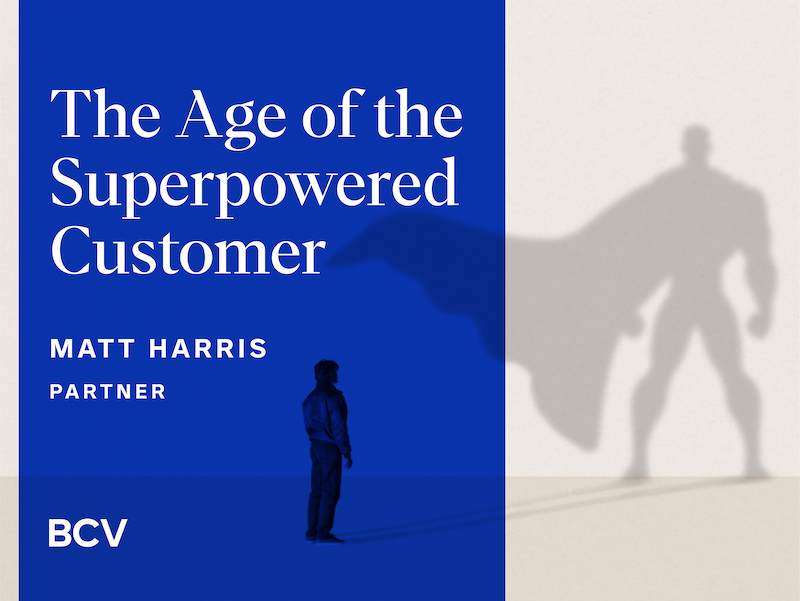
The Age of the Superpowered Customer
Generative AI can make companies more efficient, but customers have more to gain from it than they do — including in banking, commerce and medicine.

Ever since online commerce took off in the late 1990s, brands have been deploying technology to better understand their customers. The dream is to provide online customers with the type of truly personal shopping experiences they get at their favorite mom-and-pop shop. I’ve been a student of this space for over 20 years, first as a founder of the original pioneer in merchandising analytics and optimization, ProfitLogic (acquired by Oracle) starting in 1998.
At ProfitLogic, we used retailers’ own POS data to help them better understand customers’ demand patterns, shopping behaviors, and price elasticities. And for the last 15 years, as an investor at Bain Capital Ventures, I’ve backed a variety of commerce-tech companies that have done the hard work in the guts of ecommerce infrastructure to help both store-based and digital retailers and brands inch closer to the goal of true, real-time personalization. But until recently, the one-to-one engagement dream has mostly remained just that — a dream.
Now, things are finally changing. AI and machine learning techniques have advanced to the point where retail and marketing technology vendors are, finally, enabling brands to truly engage with customers on a personal level, at scale. In essence, technology is finally taking online retail back to the “olden” times of personal attention.
If you’ve been around commerce for a long time, you probably know the name Jack Mitchell. He is the proprietor of Mitchell’s of Westport, a high-end clothing stores in Connecticut, and a true pioneer of personalization in retail, chronicled in his great book, Hug Your Customers. Jack’s view is that merchants should thoroughly understand not just their customers’ merchandise needs, but everything about them.
If a shopper walks into a Mitchell’s store, it is of course helpful for the sales associate to know that he bought two suits last year, but hasn’t bought any new dress shirts in two years and has never bought a tux. But Jack also ensures all salespeople know each customer as a person; they would know the shopper’s birthday is May 3rd, his kids’ names are Sylvia and Emily, and they’re 6 and 9, that his dog is a poodle named Corky, that he works at Merrill Lynch and lives in Westport, enjoys woodworking, and really doesn’t like shopping.
Armed with all this info about the shopper, the sales associate could determine on the fly, when he walks in the door, the best way to appeal to him — not just to his clothing needs, but to his likely frame of mind at that moment — and could then make suggestions accordingly.
This kind of personal attention has led to amazing sales-per-square-foot and lifetime customer loyalty at Mitchell’s stores, yet it has seemed almost impossible to replicate online, where hundreds of millions of people make purchases every day. But AI is now finally making it possible for ecommerce companies to engage with individuals the way Jack and his family have done for over 50 years.
Recently, at NRF Retail Converge, I hosted a panel discussion alongside John Starke, VP of business development at Zulily, and Roshan Varma, VP of digital at Tapestry, whose brands include COACH, Kate Spade, and Stuart Weitzman. These two digital retail leaders shared a variety of interesting insights about how the latest commerce and marketing technologies are helping their businesses realize the goal of one-to-one engagement.
Below are a few questions I asked John and Roshan and some of their thoughts on the future of AI in retail. I hope you find their comments as interesting as I did.
How can online retailers use AI to provide an iconic level of personalized service?
John: We work with more than 15,000 brands from Kate Spade and Mattel, to small boutiques, and have millions of customers around the world. But we started back in 2010 with a mission to become the best, most personal shopping experience for moms on the internet. So we hired an in-house data team that works closely with the merchandising and marketing teams to provide them the tools they need, and we make AI and ML central to everything we do. We’re constantly testing new ways to engage better with our customers and AI and ML helps us do that at scale.
Roshan: It’s a similar story for Tapestry’s brands. It doesn’t really matter if a customer interacts with us in a store or online; AI is embedded into the tools we use to engage with customers. We have created 360-degree records of customers that show not just how many shirts they’ve bought and in what colors and what size, but also how they respond to all the marketing touchpoints and creative we’ve ever sent them, and so much more. We want to ensure that our customers feel valued and technology is helping us reach them.
We’ve reached a point where guesswork is not good enough in marketing because retailers need control and predictability at scale. But, then, marketing is a highly creative discipline. How do you balance the machine vs. the marketer?
John: We, too, are always thinking about how to unite the art and science of retail, since our creative teams understand on a fundamental level what messages and products will connect with our customers. What technology allows us to do is rapidly experiment; we test and learn constantly and have a real culture of experimentation throughout the organization.
Data science and analytics is a central team working in partnership with marketers and merchandisers on every campaign. Data is democratized at our company, so everyone from the CEO to an assistant buyer can see how their work is actually impacting the business. Everyone is an analyst — looking at, reviewing, and acting on data constantly.
Roshan: We take a very human-centered approach to AI. We believe fundamentally that it’s the creativity of our merchants and marketers that needs to shine, and AI is a tool to help them with their craft. If AI-driven marketing and merchandising platforms can help our sales associates interact in a totally personal way with each customer, whether in a store or online, then technology is helping us achieve our goals.
What are some examples of how you’ve used technology to better serve your customers?
John: Zulily is a unique retail platform because our products are sold in flash sales that are only available for 72 hours and products sell out quickly. So while this could seem like a way to frustrate consumers, it is the opposite due to our use of data and analytics.
For example, if a customer doesn’t get a product during the sale because their size was sold out, we automatically alert them when the product is coming up again. On the backend, merchants and vendors can see demand data and add specific inventory for upcoming sales, such as providing more size-large items. So while we always provide an element of excitement and surprise with our flash sales, we use technology to take care of our customers in a very personal way so they don’t feel they’ve missed out.
Roshan: We use technology everywhere. We’ve taken a modular approach by deploying a diverse tech stack: data warehouses, customer data, ecommerce, and content management platforms, product presentation tools, and more.
We use technology to make almost every marketing and merchandising decision and create trigger journeys for online customers based on their behaviors and profiles. We test all the language we use in marketing materials at a segment level. These types of tech-driven decisions helped our brands gain 700,000 new customers in the last quarter alone, and more than 1.5 million new customers during the last holiday season.
Let’s look five years into the future. Where will AI bring us then?
John: The future will belong to brands that are adaptable and willing to try new things. And it’s the right time to experiment with AI. Thankfully, with so many retail tech platforms and partners out there, you don’t have to build everything entirely in house. That said, retailers’ tech teams must have a culture of building and innovating, such as contributing to open source projects and finding unique ways to use off-the-shelf tools. We tell our engineers, innovate, don’t just integrate.
Roshan: Data collection and analytics will continue to explode and will allow retailers to use science to make every decision. AI will effectively let retailers combine magic and logic. When you use data throughout the organization, you get an increase in testing, experimentation, and learning. I’m excited to see the creativity that will be unlocked through tech to help brands remain relevant and differentiated with their customers.
Generative AI can make companies more efficient, but customers have more to gain from it than they do — including in banking, commerce and medicine.
Together with Bain & Company and Coresight Research, we are proud to present the inaugural CommerceTech Power List, recognizing the most innovative marketing, merchandising and loyalty related technologies.
A week and a half ago, Shopify released its Q2 Earning’s report and shares sank 14% on the day after the company announced it plans to lay off 10% of its global workforce (~1,000 employees). CEO Tobi Lutke acknowledged that he and his executive team had overestimated the long-standing success that e-commerce would have in…